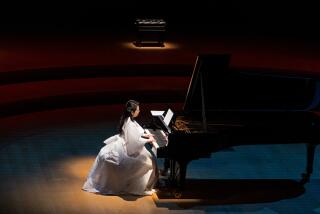THE RETURN OF SIBELIUS
Few composers have suffered a more complete decline in popularity than Jean Sibelius did after his death in 1954. At that time, in fact, many listeners did not know that his life hadn’t ended in 1927, when he wrote his last works.
During the early decades of this century, Sibelius was commonly ranked with Brahms as a symphonist. By the late-1930s he was ruled passe by critics everywhere but England (where he was more highly regarded than anywhere outside his native Finland, and where traditions die hardest).
The Sibelius of such bighearted, Romantic works as his First (1899) and Second (1902) symphonies, both in the Tchaikovskian tradition, was a popular hero when those works were new. The bleak, harmonically adventurous Fourth Symphony of 1911 was considered an aberration, with the more traditional Fifth, which followed five years later, confirming that belief. But the Sixth (1923) and Seventh (1924), his final two, more closely resembled the Fourth. None of the three found an audience.
Today, in response to the problem of diminishing concert hall audiences, anything of a relatively “conservative” nature is being considered as a device to lure the customers back. “Why not Sibelius?” seems to be a question finding favorable response among today’s conductors, notably those in the process of establishing their reputations.
Two such conductors are Vladimir Ashkenazy and Neeme Jarvi, the former having just completed the first digitally recorded Sibelius symphony cycle with the First Symphony (London 414 534, LP or CD), the latter nearing completion of another such cycle with the Second (BIS 252, LP or CD).
Ashkenazy leads London’s Philharmonia Orchestra. Jarvi’s auspices and forces are more modest: a small (but rapidly expanding) Swedish label and a Swedish provincial orchestra, the Gothenburg Symphony.
The more experienced and less effusive Jarvi, predictably, presents a more coherent overview, while Ashkenazy provides the memorable individual moments with a passion that once characterized his piano playing. And it’s hardly surprising that the richer string tone emanates from the Philharmonia Orchestra. Still, the Swedish orchestra’s response to Jarvi’s urgings has a gutsy enthusiasm that is difficult to resist.
The Sixth Symphony, with its economy of means and veiled emotions, might be considered the Sibelian contribution to the neoclassical movement of the 1920s. But it’s moody, introverted stuff, having little in common with Stravinsky’s neoclassicism. The Sixth is music unlikely to attract the casual listener.
While Ashkenazy and Jarvi bring more energy and tension to this score in their recent recordings, neither approaches the variety of sonority, the dynamic nuancing that Herbert von Karajan and the Berlin Philharmonic achieve in their moderately-paced, darkly insinuating reading (Angel DS-37821, LP).
The three shorter accompanying Sibelius pieces--”Valse triste,” the “Karelia” Suite and “En Saga”--would, however, have profited from a more direct, energetic approach than Karajan’s.
Sibelius’s 10 tone poems are contained on a pair of Chandos compact discs (8395/6; LPs previously released) in which the Scottish National Orchestra is led by Alexander Gibson.
While most of these superbly recorded performances are at least workmanlike, the most worthy and original compositions receive readings of genuine distinction: “Tapiola” (1926, Sibelius’s last completed work), where the SNO produces some quite spectacular playing, and “Luonnotar” (1913), actually a cantata: a setting for soprano and orchestra of a delectably grisly and fantastic Finnish creation legend. The excruciatingly high-flying solo part is sung by Phyllis Bryn-Julson, who scales the heights with gleeful abandon and bull’s-eye accuracy.
Being a virtuoso vehicle and among Jascha Heifetz’s showpieces, Sibelius’ Violin Concerto suffered a kinder fate than most of the composer’s works. The 1960 Heifetz recording, with the Chicago Symphony under Walter Hendl’s direction, has been issued on a generously filled compact disc that also includes Heifetz’s roughly contemporaneous recordings of Glazunov’s Concerto and the Second Concerto of Prokofiev (RCA RCD1-7019).
Heifetz’s Sibelius--pugnacious, explosive, with awesome tensile strength--is better listened to than described: an interpretation by which all others are measured. RCA’s digital CD reprocessing beams the Heifetz tone and intensity to us with thrilling immediacy.
More to Read
The biggest entertainment stories
Get our big stories about Hollywood, film, television, music, arts, culture and more right in your inbox as soon as they publish.
You may occasionally receive promotional content from the Los Angeles Times.










